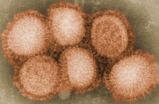(Press-News.org) The spread of antibiotic-resistance to one of the most pristine locations in Asia is linked to the annual human pilgrimages to the region, new research has shown.
Experts from Newcastle University, UK, and the Indian Institute of Technology in Delhi (IIT-Delhi), sampled water and sediments at seven sites along the Upper Ganges River, in the foothills of the Himalayas.
They found that in May and June, when hundreds of thousands of visitors travel to Rishikesh and Haridwar to visit sacred sites, levels of resistance genes that lead to "superbugs" were found to be about 60 times greater than other times of the year.
Publishing their findings today in the journal Environmental Science and Technology, the team say it is important to protect people visiting and living at these sites while also making sure nothing interferes with these important religious practices.
They argue that preventing the spread of resistance genes that promote life-threating bacteria could be achieved by improving waste management at key pilgrimage sites.
"This isn't a local problem – it's a global one," explains Professor David Graham, an environmental engineer based at Newcastle University who has spent over ten years studying the environmental transmission of antibiotic resistance around the world.
"We studied pilgrimage areas because we suspected such locations would provide new information about resistance transmission via the environment. And it has – temporary visitors from outside the region overload local waste handling systems, which seasonally reduces water quality at the normally pristine sites.
"The specific resistance gene we studied, called blaNDM-1, causes extreme multi-resistance in many bacteria, therefore we must understand how this gene spreads in the environment.
"If we can stem the spread of such antibiotic resistant genes locally – possibly through improved sanitation and waste treatment - we have a better chance of limiting their spread on larger scales, creating global solutions by solving local problems."
Funded by the Engineering and Physical Sciences Research Council (EPSRC), the aim of the research was to understand how antibiotic resistance was transmitted due to a specific human activity. Local "hot-spots" of antibiotic resistance exist around the world, particularly densely-populated regions with inconsistent sanitation and poor water quality.
By comparing water quality of the Upper Ganges in February and again in June, the team showed that levels of blaNDM-1 were 20 times higher per capita during the pilgrimage season than at other times.
Monitoring levels of other contaminants in the water, the team showed that overloading of waste treatment facilities was likely to blame and that in many cases, untreated sewage was going straight into the river where the pilgrims bathe.
"The bugs and their genes are carried in people's guts," explains Professor Graham. "If untreated wastes get into the water supply, resistance potential in the wastes can pass to the next person and spiralling increases in resistance can occur."
Worldwide, concern is growing over the threat from bacteria that are resistant to the so-called "last resort" class of antibiotics known as Carbapenems, especially if resistance is acquired by aggressive pathogens.
Of particular concern is NDM-1, which is a protein that confers resistance in a range of bacteria. NDM-1 was first identified in New Delhi and coded by the resistant gene blaNDM-1.
Until recently, strains that carry blaNDM-1 were only found in clinical settings, but in 2008, blaNDM-1 positive strains were found in surface waters in Delhi. Since then, blaNDM-1 has been found elsewhere in the world, including new variants.
There are currently few antibiotics to combat bacteria that are resistant to Carbapenems and worldwide spread of blaNDM-1 is a growing concern.
Professor Graham, who is based in the School of Civil Engineering and Geosciences at Newcastle University, UK, said the team had planned to repeat their experiments last year, but the region was hit by massive floods in June and the experiments were abandoned.
The team has since returned to Rishikesh and Haridwar and hope their work will prompt public action to improve local sanitation, protecting these socially important sites. On a global scale, they want policymakers to recognise the importance of clean drinking water in our fight against antibiotic resistance.
"What humans have done by excess use of antibiotics is accelerate the rate of evolution, creating a world of resistant strains that never existed before" explains Graham.
"Through the overuse of antibiotics, contamination of drinking water and other factors, we have exponentially speeded-up the rate at which superbugs might develop.
"For example, when a new drug is developed, natural bacteria can rapidly adapt and become resistant; therefore very few new drugs are in the pipeline because it simply isn't cost-effective to make them.
"The only way we are going to win this fight is to understand all of the pathways that lead to antibiotic resistance. Clearly, improved antibiotic stewardship in medicine and agriculture is crucial, but understanding how resistance transmission occurs through our water supplies is also critical. We contend that improved waste management and water quality on a global scale is a key step."
INFORMATION: END
River samples shed light on the spread of potential 'superbugs'
2014-02-17
ELSE PRESS RELEASES FROM THIS DATE:
New blood cells fight brain inflammation
2014-02-17
Hyperactivity of our immune system can cause a state of chronic inflammation. If chronic, the inflammation will affect our body and result in disease. In the devastating disease multiple sclerosis, hyperactivity of immune cells called T-cells induce chronic inflammation and degeneration of the brain. Researchers at BRIC, the University of Copenhagen, have identified a new type of regulatory blood cells that can combat such hyperactive T-cells in blood from patients with multiple sclerosis. By stimulating the regulatory blood cells, the researchers significantly decreased ...
Iowa State University's Wintersteen talks partnerships at national science meeting
2014-02-17
AMES, Iowa – Wendy Wintersteen, dean of Iowa State University's College of Agriculture and Life Sciences, spoke on Sunday of the importance of public-private partnerships in strengthening global food security during the annual meeting of the American Association for the Advancement of Science in Chicago.
During her talk, part of a panel on research and development for sustainable agriculture and food security, Wintersteen stressed the importance of partnerships in providing the innovation necessary to meet global challenges.
She said climate change, pests, plant ...
Scientists call for new stewardship of the deep ocean: Earth's last frontier
2014-02-17
The deep ocean, the largest domain for life on earth, is also its least explored environment. Humans are now encroaching more vigorously than ever into the ocean's deep regions, exploiting the deep's resources and placing its wealth of vibrant habitats and natural services for the planet at risk.
Lisa Levin, a biological oceanographer at Scripps Institution of Oceanography at UC San Diego, believes the vital functions provided by the deep sea—from carbon sequestration to nurturing fish stocks—are key to the health of the planet. As humans ramp up exploitation of deep-sea ...
Researchers rejuvenate stem cell population from elderly mice, enabling muscle recovery
2014-02-17
STANFORD, Calif. — Researchers at the Stanford University School of Medicine have pinpointed why normal aging is accompanied by a diminished ability to regain strength and mobility after muscle injury: Over time, stem cells within muscle tissues dedicated to repairing damage become less able to generate new muscle fibers and struggle to self-renew.
"In the past, it's been thought that muscle stem cells themselves don't change with age, and that any loss of function is primarily due to external factors in the cells' environment," said Helen Blau, PhD, the Donald and Delia ...
New 'pomegranate-inspired' design solves problems for lithium-ion batteries
2014-02-17
An electrode designed like a pomegranate – with silicon nanoparticles clustered like seeds in a tough carbon rind – overcomes several remaining obstacles to using silicon for a new generation of lithium-ion batteries, say its inventors at Stanford University and the Department of Energy's SLAC National Accelerator Laboratory.
"While a couple of challenges remain, this design brings us closer to using silicon anodes in smaller, lighter and more powerful batteries for products like cell phones, tablets and electric cars," said Yi Cui, an associate professor at Stanford ...
Worldwide study finds that fertilizer destabilizes grasslands
2014-02-17
Lincoln, Neb., Feb. 17, 2014 -- Fertilizer could be too much of a good thing for the world's grasslands, according to study findings to be published online Feb. 16 by the journal Nature.
The worldwide study shows that, on average, additional nitrogen will increase the amount of grass that can be grown. But a smaller number of species thrive, crowding out others that are better adapted to survive in harsher times. It results in wilder swings in the amount of available forage.
"More nitrogen means more production, but it's less stable," said Johannes M.H. Knops, a University ...
Study on flu evolution may change textbooks, history books
2014-02-17
A new study reconstructing the evolutionary tree of flu viruses challenges conventional wisdom and solves some of the mysteries surrounding flu outbreaks of historical significance.
The study, published in the journal Nature, provides the most comprehensive analysis to date of the evolutionary relationships of influenza virus across different host species over time. In addition to dissecting how the virus evolves at different rates in different host species, the study challenges several tenets of conventional wisdom, for example the notion that the virus moves largely ...
CU-Boulder stem cell research may point to new ways of mitigating muscle loss
2014-02-17
New findings on why skeletal muscle stem cells stop dividing and renewing muscle mass during aging points up a unique therapeutic opportunity for managing muscle-wasting conditions in humans, says a new University of Colorado Boulder study.
According to CU-Boulder Professor Bradley Olwin, the loss of skeletal muscle mass and function as we age can lead to sarcopenia, a debilitating muscle-wasting condition that generally hits the elderly hardest. The new study indicates that altering two particular cell-signaling pathways independently in aged mice enhances muscle stem ...
Years after bullying, negative impact on a child's health may remain
2014-02-17
BOSTON (Feb. 17, 2014) —The longer the period of time a child is bullied, the more severe and lasting the impact on a child's health, according to a new study from Boston Children's Hospital published online Feb. 17 in Pediatrics. The study is the first to examine the compounding effects of bullying from elementary school to high school.
"Our research shows that long-term bullying has a severe impact on a child's overall health, and that its negative effects can accumulate and get worse with time," says the study's first author Laura Bogart, PhD, from Boston Children's ...
Why does the brain remember dreams?
2014-02-17
This news release is available in French. Some people recall a dream every morning, whereas others rarely recall one. A team led by Perrine Ruby, an Inserm Research Fellow at the Lyon Neuroscience Research Center (Inserm/CNRS/Université Claude Bernard Lyon 1), has studied the brain activity of these two types of dreamers in order to understand the differences between them. In a study published in the journal Neuropsychopharmacology, the researchers show that the temporo-parietal junction, an information-processing hub in the brain, is more active in high dream recallers. ...


